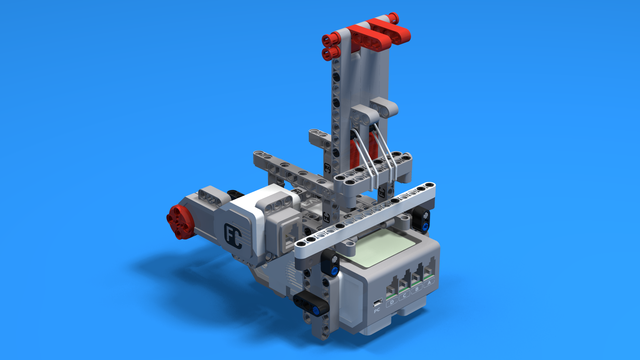
Launcher Gate, built with LEGO WeDo 2.0
These are building instructions for a Launcher Gate. The gate is used in connection with the LEGO WeDo 2.0 lauchner that lauches objects.
- #772
- 18 May 2019

These are building instructions for a Launcher Gate. The gate is used in connection with the LEGO WeDo 2.0 lauchner that lauches objects.

This is a simple chassis that uses two motors to control the robot and two omni wheels at the back for greater maneuverability. It also have low center of the mass which makes it more stable for higher attachments.
The program for this robot is at programs/uxgw6b-roberto-bot-chassis-controls-with-modkit

This are building instructions for a second mechanism for collecting cubes. This mechanism is designed for VEX Robot Base 1 and can be used for solving VEX IQ Challenge Highrise 2014-2015.

Building instructions for the robot build with LEGO Mindstorms EV3. It is called "Frankenstein" because the two motors are in two different directions.

Building instructions for the catapult that could be placed over the LEGO Mindstorms EV3 Brick. The idea of the catapult it to throw objects. The fact that it is over the brick makes it very convenient to place the motors below the brick and to use the Catapult.
This robot construction itself was used in the FIRST LEGO League Senior Solutions competition

This is a heavy lifting attachment and it can lift mission models vertically. It is build entirely from LEGO MINDSTORMS Robot Inventor 51515 parts. This is one of the more complex and interesting attachments that we demonstrate in the course and it show how a few gear wheels and levers could be used to change the motion from circular to linear. This is powerful concept that could be very valuable during FIRST LEGO League competitions.

This almost box robot is build from the LEGO Mindstorms Robot Inventor set. The idea behind this robot is to be able to build it from Robot Inventor and to use it during FIRST LEGO League competitions

This is a cool scissor mechanism that looks like the sting of a scorpion. It is powered by a medium motor and at the top there is a touch sensor, to detect if something has been stung! The sting is used in Scorpion - LEGO EV3 Robot.

This is the attachment of Team "Nightbeast", with which they do:
M11–Escape Velocity and M13–Observatory
The Observatory result depends on the model. Sometimes the pointer is in the orange area otherwise in the white area.

Soon after a launch, rocket engines often separate away from spacecraft by design, but that’s long before the spacecraft leaves the pull of gravity. So why doesn’t the spacecraft fall back to earth?
The robot needs to impact the strike pad hard enough to keep the spacecraft from dropping back down.
Scoring Requirements
(mission descriptions source https://www.first-lego-league.org/)

If you take a look at the videos for this attachment you will see a nice idea on taking the track and the ambulance. These two vehicles from the FIRST LEGO League 2013 competition had to be collected and returned back to base.
Built from LEGO Mindstorms EV3 parts.

Building instructions for a LEGO Mindstorms Catapult Motor and Touch Sensor that are used for triggers for firing objects

This attachment was intended for and tested on the Gazon, LEGO Education SPIKE Prime competition robot. It is meant to help the robot complete the 5th mission of the FLL Cargo Connect competition.

This is the second type of an active geared attachment. "Active" means that is is power by a motor. "Geared" means that it uses gears. "Reusable" means that you can easily extend the attachment with additional parts - eg - you can reuse it. It shows a basic principle of how power is transferred between different axles that have different orientation in space- like when one of the axles is horizontal and the other is vertical. It's built with LEGO Education SPIKE Prime parts and could be used in competitions in robotics like FIRST LEGO League/World Robotics Olympiad and others. It's designed for Luly, small LEGO Education SPIKE Prime competition robot with 3D building instructions. Check the courses in which this attachment is used for more information and tutorials on how to use it.

These are instructions on how to build the:
You can find more building instructions and tips and tricks about the competition on this page.

Building instruction for the power switch mission model. The model is used in the Power supply mission of FLLCasts Off-season Challenge 2019.

Roberto is one handed robot with four bars mehanizm. He is more durable then Pesho.
This robot is based on Roberto Chassis.
Program for this robot available here.

This is a Material supplementing the Instructors training course. Attached is our methodology for working with students. If you spend some time to read it beforehand, we can discuss only the questions that you have, instead of listening to the whole thing. That will be a more efficient usage of our time in the training.